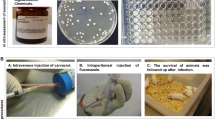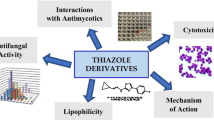Abstract
6-[(N-2,3-Dichlorophenyl)amino]-7-chloro-5,8-quinolinedione (RCK11) was tested forin vivo antifungal activities in the treatment of systemic infection withCandida albicans in normal mice compared with ketoconazole. The therapeutic potential of RCK11 had been assessed by evaluating their activities (survival rates) against systemic infections in normal mice. ED50 of intraperitoneally administered RCK11 was 0.10±0.01 mg/kg but that of ketoconazole had 8. 00±0.73 mg/kg respectively. When RCK11 was administered intravenously at the ED50 (0.10 mg/kg), the colony counts ofCandida albicans in the liver after 7 days and 14 days were reduced as likely as ketoconazole at the ED50 (8.00 mg/kg), and the better survival rates than ketoconazole were achieved after 14 days. The results suggest that RCK11 may be a potent antifungal agent.
Similar content being viewed by others
References Cited
Bowman, C. M., Porter, T. H., Skelton, F. S. and Folkers, K., 5,8-Quinolinequinone analogs which inhibit mitochondrial succinoxidase.J. Med. Chem. 14, 206 (1973).
Clark, A. C., The need for new antifungal Drugs, In Fernandes, P. B. (Eds.),New Approaches for Antifungal Drugs. Birkhaeser, Boston, 1992, pp. 1–19.
Dupouy-Camet, J., Paugam, A. and Tourte-Schaefer, C., Yeast susceptibility testing.Lancet, 338, 383 (1991).
Fisher, M. A., Lee, P. G. and Tarry W. F., Fluconazole treatment of candidiasis in normal and diabetic rats.Antimicrob. Agents Chemother., 33, 1042–1045 (1989).
Georgiev, V. S., Fungal infections and the search for antifungal agents, In Georgiev, V.S. (Ed),Antifungal Drugs. New York Academy of Sciences, New York, 198, pp. 1–4.
Georgopapadakou, N. H. and Walsh, J., Human mycoses: Drugs and targets for emerging pathogens.Science, 264, 371–373 (1994).
Hudson, A. T., Atovaquone-A novel agent for the treatment of malaria, PCP and toxoplasmosis, In Bentley, P. H. and Ponsford, R. (Ed),Recent Advances in the Chemistry of Anti-infective Agents. Royal Society of Chemistry, 1992, pp. 322–335.
Jeschke, P., Linder, W., Mueller, N. and Dehne, H. W., Fungicides based on amino-substituted quinolinequinones.Ger. Offen., DE 4,208,874 (1993).
Jeschke, P., Linder, W., Mueller, N., Harder, A. and Mencke, N., New 6(7)amino-substituted-5,8-quinolinediones to combat endoparasites.Eur. Pat., Appl. EP 519,290 (1992).
Mcginnis M. R. and Rindali, M. G., Antifungal drug, In Lorian V. (Ed),Antibiotics in Laboratory Medicine. 3rd ed., Williams and Wilkins, Baltimore, 1991, pp. 198–256.
Park, Y. M., Kim, H. J., Kim, D. H., Lee, I. K. and Ryu, C. K., The evaluation ofin vivo antifungal activities of 6-[(N-4-fluoro)amino]-7-chloro-5,8-quinolinediones.Yakhak Hoeji, 40, 4–9 (1996).
Rex, J. H., Rinaldi, M. G. and Pfaller, M. A., Resistance ofCandida species to fluconazole.Antimicrob. Agents Chemother., 39, 1–8 (1995).
Rex, J. H., Pfaller, M. A., Rinaldi, M. G., Polak, A. and Galgiani, J. N., Antifungal susceptibility testing.Clin. Microbiol. Rev., 6, 367–381 (1993).
Roberts, H., Choo, W. M., Smith, S. C., Marzuki, S., Linnane, A. W., Porter, T. H. and Folkers, K., The site of inhibition of mitochondrial electron transfer by coenzyme Q analogs.Arch. Biochem. Biophys., 191, 306–315 (1978).
Ryu, C. K., Kim, D. H., Yun, Y. P., Heo, M. Y., Lee, B. M., Jang, S. J., Kim, H. J. and Park, Y. M., The evaluation of in vivo antifungal activities and toxicities of 6-[(N-4-chlorophenyl)amino]-7-chloro-5,8-quinolinediones.Yakhak Hoeji, 39, 417–426 (1995).
Ryu, C. K. and Kim, D. H., The antifungal susceptibility tests of 5,8-quinolinediones againstCandida sp.Arch. Pharm. Res., 17, 483–486 (1994a).
Ryu, C. K. and Kim, H. J., The synthesis of 6-(N-arylamino)-7-chloro-5,8-quinolinedione derivatives for evaluation of antifungal activities.Arch. Pharm. Res., 17, 139–144 (1994b).
Sheehan, D. J., Espinel-Ingroff, A., Moor, D. J. and Webb, C. D., Antifungal susceptibility tests of yeasts: A brief overview.Clin. Infec. Diseases, 17(Suppl. 2), 494–500 (1993).
Sternberg, S., The emerging fungal threat.Science, 266, 1632–1634 (1994).
Sugar A. M., Salibian, M. and Goldani, L. Z., Saperconazole therapy of murine disseminated candidiasis: Efficacy and interaction with amphotericin B.Antimicrob. Agents Chemother. 38, 371–373 (1994).
Viscoli, C. and Terragna, A., Fluconazole in the treatment of candidiasis in immunocompromised children.Antimicrob. Agents Chemother., 35, 365–367 (1991).
Author information
Authors and Affiliations
Rights and permissions
About this article
Cite this article
Ryu, CK., Kim, DH., Kim, DH. et al. 6-[(N-2,3-dichlorophenyl)amino]-7-chloro-5,8-quinolinedione treatment of candidiasis in normal mice. Arch. Pharm. Res. 19, 197–200 (1996). https://doi.org/10.1007/BF02976889
Received:
Issue Date:
DOI: https://doi.org/10.1007/BF02976889




